How to Remove AI from AI Written Content: A Clear Guide
Ashley Merit
Content writer and editor for Netus.AI
Table of Contents
How to Remove AI from AI Written Content. AI-generated content has become increasingly common in recent years, with many businesses and individuals relying on AI to create articles, reports, and other written content. While AI can produce content quickly and efficiently, it can also result in articles that lack creativity, originality, and accuracy. As a result, many content creators are looking for ways to remove AI from their written content and create more engaging and authentic articles.
One of the main challenges of removing AI from AI-generated content is detecting when AI has been used in the first place. While some AI-generated articles may be obvious due to their lack of coherence or incorrect information, others can be more difficult to identify. This is where AI detection tools can be useful, as they can analyze written content and determine whether AI has been used in its creation.
Once AI has been identified in written content, there are a few different approaches that content creators can take to remove it. One option is to manually edit the content, removing any sections that were generated by AI and replacing them with original writing. Another approach is to use AI-powered content creation tools that allow users to input their own ideas and writing style, while still benefiting from the speed and efficiency of AI.
Understanding AI-Generated Content
Characteristics of AI-Written Text
AI-generated text refers to the content that is produced by artificial intelligence systems. These systems use natural language processing (NLP) algorithms to analyze and understand human language and then generate text that is similar to what a human would write. AI-written content can be identified by several characteristics, such as:
- Lack of coherence: AI-written content often lacks coherence and may jump from one topic to another without any clear connection between them.
- Repetition: AI systems may repeat the same phrases or sentences multiple times in the text.
- Lack of creativity: AI-generated text is often bland and lacks creativity, as the algorithms are not capable of producing unique and creative content.
- Grammatical errors: AI systems may produce text with grammatical errors or awkward phrasing.
AI Detection Systems
To identify AI-generated content, there are several AI detection systems available that use machine learning algorithms to analyze text and identify patterns that indicate the content was generated by an AI system. Some of the popular AI detection systems include GPTZero and other similar tools.
These systems analyze various features of the text, such as sentence structure, word choice, and repetition patterns, to identify whether the content was generated by an AI system or a human writer. AI detection systems are becoming increasingly important as AI-generated content becomes more prevalent, especially in industries such as journalism and marketing.
In conclusion, understanding the characteristics of AI-written content and the tools available to detect it is essential for anyone working with text-based content. As AI technology continues to advance, it is likely that AI-generated content will become even more prevalent, making it crucial to develop effective strategies to identify and remove it from our content.
Methods to Remove AI Footprints
Paraphrasing and Sentence Structure
One of the most effective ways to remove AI footprints from AI written content is by paraphrasing and adjusting sentence structures. This method involves changing the wording and sentence structure of the original text to make it sound more natural and human-like. By doing so, the content will appear less robotic and more authentic.
To bypass AI detection, it is important to avoid using the same phrases and sentence structures repeatedly. This can be achieved by using synonyms, changing the order of sentences, and rephrasing sentences. By doing so, the content will sound more natural and less like it was generated by a machine.
Incorporating a Personal Touch
Another way to remove AI footprints from AI written content is by incorporating a personal touch. This method involves adding personal anecdotes and experiences to the content. By doing so, the content will sound more authentic and human-like.
To humanize AI text, it is important to add personal anecdotes and experiences that are relevant to the topic. This can be achieved by sharing personal stories, experiences, and opinions. By doing so, the content will appear more genuine and trustworthy to the reader.
By using these methods, AI footprints can be removed from AI written content, making it appear more natural and authentic.
Tools and Techniques for Humanizing Content
AI Humanizer and Editing Tools
One effective way to humanize AI-written content is to use AI humanizer and editing tools. These tools are designed to improve the readability and coherence of AI-generated text by making it more natural and engaging. One such tool is Quillbot, which uses advanced algorithms to rephrase and restructure sentences in a way that makes them more human-like.
Another tool that can be used is the humanizer tool, which is designed to add a human touch to AI-written content. This tool analyzes the text and suggests changes to improve its tone, style, and word choices. By using these tools, writers can quickly and easily improve the quality of their content and make it more appealing to readers.
Manual Editing Strategies
While AI humanizer and editing tools can be effective, they are not always perfect. Sometimes, manual editing is required to achieve the desired level of humanization. One effective strategy is to read the text aloud and identify areas that sound unnatural or robotic. Once these areas have been identified, the writer can manually edit them to make them more human-like.
Another strategy is to focus on word choices. AI-generated text often uses technical or jargon-heavy language that can be difficult for readers to understand. By replacing these words with simpler, more common words, writers can make their content more accessible and engaging. Additionally, using descriptive language and vivid imagery can help to create a more human-like tone and style.
In conclusion, humanizing AI-written content is essential for creating engaging and effective content. By using AI humanizer and editing tools, as well as manual editing strategies, writers can improve the readability and coherence of their content and make it more appealing to readers.
Ensuring Content Authenticity
Diverse Vocabulary and Active Voice
One way to ensure content authenticity is by using a diverse vocabulary and active voice. This will help to distinguish the content from AI-generated text. AI-generated text often uses repetitive language and passive voice, which can make the content sound robotic and unnatural.
Using a diverse vocabulary will also help to make the content more engaging and interesting to readers. This can be achieved by using synonyms, antonyms, and other related words to convey the same message. Additionally, using active voice will make the content more direct and engaging.
Adding Personal Stories and Anecdotes
Another way to ensure content authenticity is by adding personal stories and anecdotes. This will help to make the content more relatable and engaging to readers. Personal stories and anecdotes can also help to establish the author’s credibility and expertise on the topic.
When adding personal stories and anecdotes, it is important to ensure that they are relevant to the topic and add value to the content. They should also be written in a clear and concise manner, and should not distract from the main message of the content.
In summary, using a diverse vocabulary and active voice, as well as adding personal stories and anecdotes, can help to ensure content authenticity and distinguish it from AI-generated text.
Navigating AI Detection Algorithms
As AI technology advances, so do the algorithms used to detect AI-written content. In order to successfully remove AI from AI-written content, it is important to understand how these detection algorithms work and how to bypass them.
Bypassing Advanced AI Detectors
One way to bypass advanced AI detectors is to vary the style and voice of the content. AI detection algorithms often look for patterns in the content, such as sentence structure and word choice. By varying these elements, it becomes more difficult for the algorithm to detect the use of AI.
Another way to bypass AI detectors is to use an AI content detection remover. These tools, such as Copyleaks and Turnitin, use their own AI algorithms to detect and remove AI-written content. However, it is important to note that these tools are not foolproof and may not catch all instances of AI-written content.
Staying Ahead of AI Detection Systems
To stay ahead of AI detection systems, it is important to keep up with the latest developments in AI technology and detection algorithms. This can be done by following industry news and attending conferences and events.
It is also important to be aware of the ethical implications of using AI to create content. While AI can be a useful tool, it should not be used to deceive or mislead readers. By being transparent about the use of AI in content creation, writers can build trust with their audience and avoid potential legal and ethical issues.
Overall, navigating AI detection algorithms requires a combination of technical knowledge and ethical considerations. By staying informed and using the right tools and techniques, writers can successfully remove AI from AI-written content and maintain their credibility with readers.
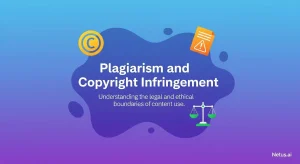
Plagiarism and copyright infringement | NetusAI
Plagiarism and copyright infringement Writers along with academic folks and students really need to steer clear of plagiarism and copyright infringement. They do this to
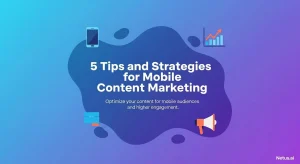
Tips and strategies for mobile content marketing | NetusAI
5 Tips and strategies for mobile content marketing Mobile content really matters a lot these days. Pretty much 98 percent of adults in the U.S.
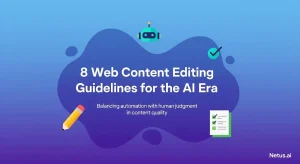
Web content editing guidelines for the AI era | NetusAI
8 Web content editing guidelines for the AI era Editing web content turns out to be pretty tough, especially when generative AI gets involved in
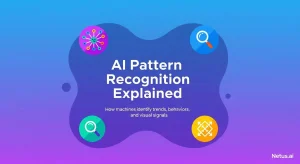
Explaining AI pattern recognition | NetusAI
AI pattern recognition explained Pattern recognition in AI really forms the backbone of what we see in artificial intelligence today. It allows machines to spot
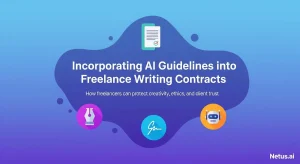
AI Guidelines in Freelance Writing Contracts | NetusAI
Incorporating AI guidelines into freelance writing contracts With AI content prevalent and ranking high on Google, freelance writing contracts must include AI guidelines. This is
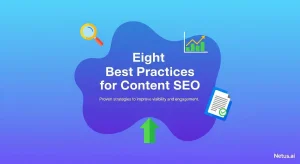
Best practices for content SEO | NetusAI
Eight best practices for content SEO Content has to show up and grab attention if it wants to do well. Content SEO takes care of

